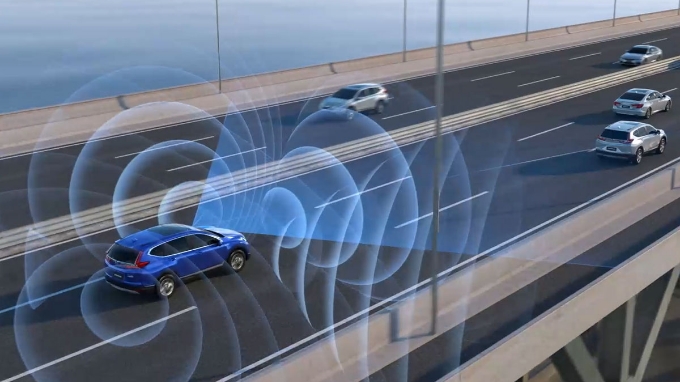Honda SENSING Elite, Honda SENSING 360+Advanced In Lane Driving with Hands-off Capability / Advanced In Lane Driving

Technology overview
Assisting with expressway driving
While driving on an expressway, the system utilizes high-definition maps and the global navigation satellite system (GNSS) to identify the vehicle position and obtain road information. Under certain conditions, the system assists with driving while the driver takes hands off the steering wheel. The system operates the accelerator, brake pedal and steering wheel to maintain a pre-set vehicle speed and stay in the lane even while the driver takes hands off the steering wheel. When there is a car in front, the system follows that vehicle while maintaining a proper following distance. When approaching a curve, the system detects the curvature of the lane in advance and performs deceleration and/or acceleration before and after going around the curve to give the driver peace of mind while assisting with driving.
Note: Availability of the hands-off capability varies depending on the country/region. In regions where hands-off capability is not available, the system assists the driving in the same way while the driver keeps hands on the steering wheel.
How it works

The system assists the driver with comfortable in-lane driving on an expressway by recognizing the external environment including lane markings and other vehicles using the front sensor camera and radar sensors and by recognizing the vehicle position and road information using high-definition map data. The system also detects the driver’s facial orientation, posture and conditions using the driver monitoring camera and hands-on sensor and assists the driver with safe driving.
How it helps
While driving on an expressway with Adaptive Cruise Control (ACC) with Low Speed Follow and the Lane Keeping Assist System (LKAS) activated, the system uses high-definition maps to obtains information on the road ahead while also detecting other vehicles and road conditions in the vehicle’s surroundings using a camera and radar.

When the hands-off function becomes available, the system notifies the driver with audible and visual alerts.
When there is no car in front of the vehicle, the system drives the vehicle along the middle of the lane while maintaining the pre-set vehicle speed. When there is a car in front, the system follows the car while maintaining a proper following speed.

When this function will be deactivated in some situations, such as when the vehicle exits from an expressway, the system provides audible and visual warnings to prompt the driver to take over the driving.

While confirming the vehicle’s surroundings are clear using the front sensor camera and radar sensors, the system adjusts the vehicle speed to achieve stable in-lane driving while predicting the behavior of other vehicles, which will reduce driver burden.
Moreover, the system links the high-definition maps and route information from the navigation system to calculate which lanes the vehicle needs to be on to reach the destination.
When entering a curve, the system automatically adjusts the vehicle speed to realize a suitable speed for the curve. If another vehicle enters the main lane from the merging lane, the system automatically reduces the vehicle speed and gives way to the merging vehicle.
In addition, by detecting the driver's condition with the driver monitoring camera, the system assists the driver by automatically starting the vehicle when the vehicle in front starts moving, particularly while driving through traffic congestion.
Commitment of Honda
Under the theme of “relaxed driving,” this function was developed with an aim to achieve vehicle behavior as close to natural human driving as possible. For example, when rounding a curve, the system drives the vehicle slightly inside the center of the lane. When the vehicle in the adjacent lane is drifting toward the vehicle, the system drives the vehicle slightly over to the side to secure enough space to ensure peace of mind for the driver.
[Video] Function introduction<CG>
The individual functions of the driver-assistive system have limited capabilities (e.g. recognition capability and control capability). Please do not overestimate the capabilities of any function and drive safely while paying constant attention to the vehicle’s surroundings.
A system may not work or perform adequately depending on road conditions, weather conditions and vehicle conditions.
Depending on the model and timing of the market launch of the model, descriptions provided on this page and the actual functions available on customers’ vehicles may be different. For the functions available for each vehicle, please check the owners’ manual of the respective vehicle.
Related Contents
TechnologyAdvanced In Lane Driving with Hands-off Capability / Advanced In Lane Driving




